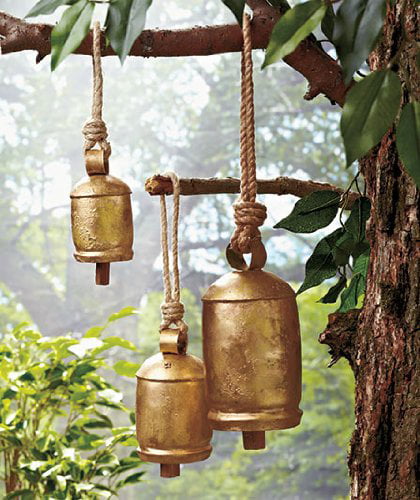

The sound was purportedly like that of metal hammers beating on anvils. It had metal bells (or bars) which were played via a chromatic keyboard. The instrument he used was called a carillon and had a range of two and a half octaves. The first composer to write for the glockenspiel in the orchestra was Georg Friedrich Handel, who included it in his oratorio Saul (1739). The glockenspiel becomes an orchestra instrument They replaced the unwieldy bells with a row of bars after the fashion of the metallophone from eastern Asia. The first step toward the glockenspiel used in the modern orchestra was taken by the Dutch in the 17th century. In the 17th century smaller glockenspiels began to be fitted with a keyboard which made it possible to perform more demanding parts. In the 14th century there were two types of glockenspiel: large instruments in church towers and smaller ones for playing at home. These instruments, known as cymbala, featured small, round bells made of bronze which were suspended from a rail and struck by one or two musicians. In the 9th century hemispherical, pear-shaped bells were widespread among occidental monks. In China, bells were already part of the orchestra 4,000 years ago. These instruments had a compass of more than three octaves, the bars were made either of the same metal as bells, or of silver, and were already arranged in the manner of a piano keyboard. Metallophones were first mentioned in Europe in the middle of the 18th century.

Metallophones have been played in eastern Asia for more than 1,000 years the saron and the gendèr, for instance, still perform a crucial role as melody instruments today. Smaller glockenspiels worked on the same principle. This type of music is still very much a vital part of local tradition in many areas and a great tourist attraction. In many places the sequence of notes is played by an automatic mechanism which is operated by a clockwork motor. In Germany the playing of fixed bells in church or town hall belfries is known as Beiern. Strict regulations and local tradition govern the order in which the notes are played. Exactly how many musicians are required depends on the size of the instrument. One or more musicians play several overlaid melodic phrases. The "genuine" glockenspiel consists of a set of bells of various sizes. The instrument now known as the glockenspiel is a hybrid, resulting from the fusion of two different types of instrument, the "genuine" glockenspiel with real bells, and the metallophone. Lower-pitched glockenspiels have short resonators and are generally known as metallophones. Children's instruments have a smaller range, are tuned diatonically and have bars resting over a frame like a trough. Carl Orff used it from the 1930s for his Method. Like the xylophone, the glockenspiel is also a great favorite with children. Initially only a substitute for real bells, this arrangement of metal bars soon developed into a musical instrument in its own right and retained the name "glockenspiel". At the end of the 17th century steel bars began to replace the bells. The very first instruments to carry this name did indeed consist of a set of small bells which were played either by a group of musicians or struck by means of a complicated mechanism. The name glockenspiel is German and means "bell play" it refers to the sound of small bells. Tuning: Equal temperament, the tuning tone is generally 442 hertz.Damper pedal: Glockenspiels on a stand usually have a damper pedal, table glockenspiels do not.Resonator: The case acts as the soundbox (resonator).

The table glockenspiel is placed on a table. The stand of the open glockenspiel is partly enclosed in the case. Stand – The “open glockenspiel": Metal stand height is adjustable (81–94 cm), usually on wheels.Table-shaped frame: Dimensions: approx.Metal Bars: Steel alloy Width: 2.5–3.1 cm Thickness: 0.5–1 cm.Classification: Idiophone, metallophone, percussion instrument with definite pitch, mallet instrument.You will easily notice that I am not a native English speaker. Besides, it's always enriching to read very interesting opinions. I'm not a bassist, but I compose in an amateur way and obviously I have to shape the bass many times. I came across this fabulous forum (which I didn't know). I know that marketing works miracles, but an expensive product does not mean that it is good (or very good). Surfing the internet I saw the comparison Sibelius vs Harmony Assistant and it caught my attention and I went in to read. very well and I know about its impressive capacity, which as I say, is a bit of a craft. I myself am a user of Overture 5, by Sonic Scores. I wouldn't recommend it to anyone who is just trying to make a few simple scores, or that his job is that of copywriter-editor.

If there were, it wouldn't indicate H.A.'s clear shortcomings in magnetism and that he's very handy.


 0 kommentar(er)
0 kommentar(er)
